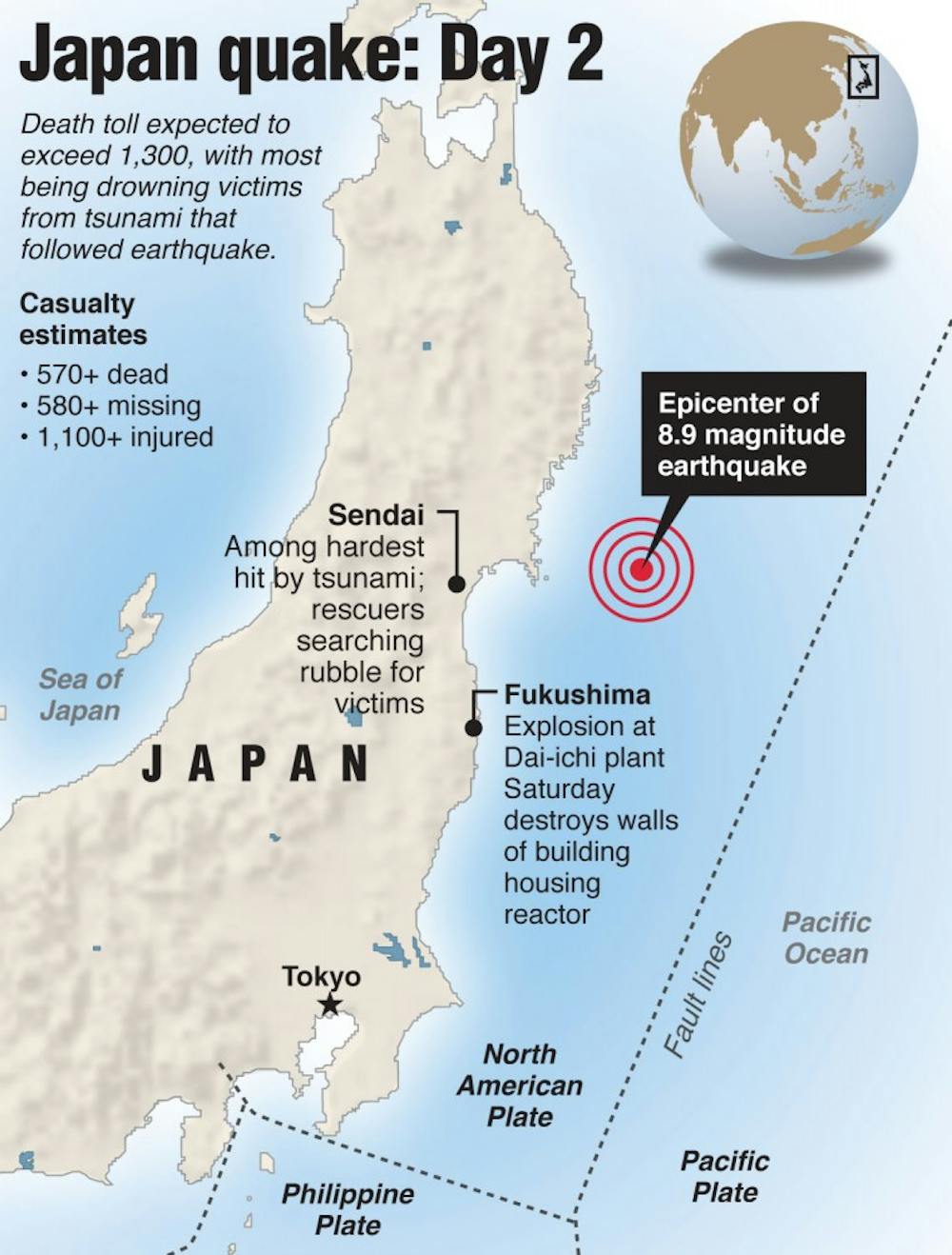Japanese nuclear reactor may have meltdown after earthquake, tsunami leave hundreds dead

With JAPAN-QUAKE, by MCT
03000000; DIS; krtdisaster disaster; krtnews; krtworld world; krt; mctgraphic; krtworldnews; 03002000; 03007000; 03008000; 03015001; 03015002; 03017000; 13015001; 17000000; krtaccident accident; krtflood flood flooding; krtquake earthquake quake; krtweather weather; meteorology meteorological disaster; nuclear accident; rescue; WEA; krt mct; yingling; japan; JPN; krtasia asia; death; destruction; epicenter; fukushima; map; senadi; tokyo; tsunami; wave; 2011; krt2011; quake; japan-quake
By Rex Crum and Lisa Twaronite
TOKYO — Tensions in Japan remained high Saturday as officials worked to stabilize a nuclear reactor following an explosion that resulted from damage caused by the strongest recorded earthquake in the nation's history.
Japanese officials reported on Saturday night local time that radioactive leaks from the Fukushima Daiichi No. 1 nuclear reactor were receding. The government earlier extended a nuclear emergency evacuation order requiring residents within 12 miles of the Daiichi plant to leave the area, up from an earlier radius of six miles.
Media reports said about 40,000 people had evacuated from the areas around the Fukushima plants, which are operated by Tokyo Electric Power Co.
Tokyo Electric officials said all six nuclear reactors at the power station had been shut down following Friday's magnitude-8.9 earthquake. Only three of the units were in operation when the earthquake hit. Three others were out of service in connection with regular inspections, the company said.
Four workers were reported injured at the No. 1 reactor at Fukushima Daiichi nuclear power plant operated by Tokyo Electric Power, or Tepco. A white cloud of steam or smoke appeared around the plant, visible in televised footage.
At a press conference, Japanese Chief Cabinet Secretary Yukio Edano said that the blast didn't damage the reactor container, only the structure outside it, and that there was no major radiation leakage with the explosion.
"I think we can get this under control" by cooling the reactor with seawater, Edano said, a process he said could take five to 10 hours.
Tepco's Fukushima reactors are about 150 miles north of Tokyo, and about 40 miles from the epicenter of the earthquake. Japanese broadcaster NHK World said there were at least 680 confirmed dead from the earthquake, and that the death toll could rise above 1,000.
NHK earlier cited Fukushima authorities as saying that the ceiling of the reactor building had collapsed. It said radioactivity at the site was rising to 20 times normal levels. Other reports said the walls of the building that housed the reactor had been blown away.
Earlier Saturday, authorities said that Tepco had succeeded in relieving the pressure building up in the reactor.
"If the water level remains at this level, the reactor core might be damaged, but we are now pouring water into the reactor to prevent it from happening," Dow Jones Newswires quoted a Tepco spokesman as saying.
Japanese media had reported earlier Saturday that the reactor could already be experiencing a meltdown, but the risk of widespread radiation leakage from it would be mitigated if the container of the reactor were to remain intact.
A nuclear meltdown occurs when a reactor's cooling system fails, allowing the nuclear fuel to overheat and melt. If the container is damaged, the melting fuel could release radioactive substances into the air.
The Tepco plant did emit some radiation early Saturday morning, as part of the utility's controlled release of radioactive steam. That was part of government-mandated steps to relieve the growing pressure in the reactor.
Damon Moglen, director of the climate and energy program at Friends of the Earth, an international network of organizations focusing on environmental issues, said Tepco and the Japanese government are still not being forthcoming enough with information about the scope of the nuclear reactor situation.
"They are handing out nothing and treating it like something," Moglen said. "Some extremely radioactive elements may have been released and we need more information to say whether we are on the down or up slope of this accident."
Tepco also said another nuclear-power plant nearby, Fukushima Daini, was experiencing pressure increases inside its four reactors due to cooling-system damage.
Aftershocks struck Iwate, Miyagi, Aomori and Fukushima late Saturday.
Friday's earthquake struck at 2:46 p.m. local time Friday near the east coast of Honshu, about 231 miles northeast of Tokyo, according to the U.S. Geological Survey. It lasted about two minutes.
The quake also triggered a tsunami that sent strong waves crashing on Hawaii and also caused minor damage some 5,000 miles across the Pacific Ocean in Oregon and California.
The U.S. Coast Guard was searching for a person who was swept out to sea in Northern California.
According to Japanese media, some 1,600 people are confirmed dead or missing after a tsunami wave struck in coast areas around Sendai near the epicenter.
Kyodo reported late Saturday that about 9,500 people are unaccounted for in the town of Minamisanriku in Miyagi, citing prefectural officials. The figure is more than half of the town's population of about 17,000.
Sendai, the capital of Miyagi prefecture and home to about 1 million people, is about about 115 miles from Tokyo. Its airport was deluged and parts of the tarmac remained flooded Saturday.
The death toll was expected to climb as many reported missing in coastal areas swept by the tsunami are unlikely to have survived.
Dramatic Japanese television footage showed a helicopter rescuing two people from a rooftop surrounded by water in a tsunami-stricken town. Separate footage showed a hospital and a school with written pleas for help to rescuers.
A ship that was earlier reported missing was found, and all 81 people aboard were rescued, according to an AFP report.



